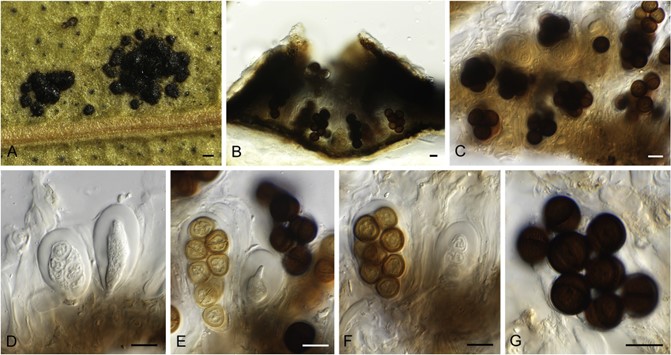Neothyriopsis sphaerospora (Marasas) Crous, comb. nov.
MycoBank number: MB 832029; Index Fungorum number: IF 832029; Facesoffungi number: FoF 12341 ; Fig. 58.
Basionym: Thyriopsis sphaerospora Marasas, Bothalia 9: 206. 1966.
Diagnosis: Associated with corky lesions on leaves of Eucalyptus species. The ascostromata are raised, brown to black in colour, and occur singly or in clusters on both leaf surfaces. These structures are usually found on healthy leaf tissue, and subsequently form small, discrete, corky, necrotic lesions, extending through the leaf lamina. This fungus infects both juvenile and mature foliage, and severe infection leads to premature defoliation. Ascospores are dark brown, thick-walled, subglobose to globose, finely verruculose, medianly 1-septate, 10– 15 × 10– 12.5 μm.
Description and illustration: Marasas (1966).
Typus: South Africa, Gauteng, Nylstroom, on E. camaldulensis, Aug. 1963, W.F.O. Marasas (holotype PREM 42659); Western Cape Province, Stellenbosch, Stellenbosch Mountain, on Eucalyptus sp., 2003, P.W. Crous (epitype designated here CBS H-24031, MBT388155).
Note: The ITS sequence obtained directly from fungal material removed from the leaf surface showed some similarity to the genus Blastacervulus, e.g. with Blastacervulus eucalypti (as Heteroconium eucalypti; GenBank DQ885893.1, 707/821 (86 %), 55 gaps (6 %)).

Fig. 58. Neothyriopsis sphaerospora (epitype, CBS H-24031). A. Disease symptoms. B. Vertical section through ascoma. C–G. Asci and ascospores. Scale bars = 10 μm.
Species
